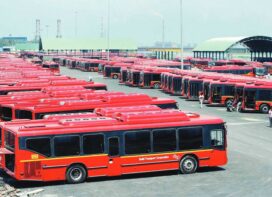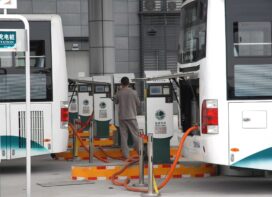
BRT is also known as a busway or a transitway. It describes a high-capacity urban public transport system with its own right of way, vehicles at short headways, platform-level boarding, and pre-ticketing. Purists will argue that a BRT needs all these attributes, but often the ticketing system is on-board – albeit cashless and fast – so as not to slow down boarding times.
The right physical infrastructure is required for a BRT. Separation of the bus corridor from traffic is mandatory and grade separation to avoid intersections is ideal. Dedicated bus stations for boarding are needed, as are supporting services to operate the system and keep passengers informed. BRT systems are at the top of the bus service tree because they can move a lot of people quickly. Think of a train line without the rails. The bus stops are like stations where connections are easily identified, passenger information is everywhere, and services are reliable and frequent.
In addition to the buses and physical infrastructure, combinations of ITS systems are necessary to deliver reliable service from a passenger’s point of view. Planned high frequency services require planning tools with an optimiser built on a superior algorithm that delivers everything bus operators need to run their business efficiently, to calculate the optimum combination of buses and drivers, so that a bus starts a service every 5, 6 or 7 minutes in peak and only marginally less frequently out of peak. This means passengers do not need a timetable and can just show up.
With many buses, the timetable is not used by passengers so it is important that they arrive with a regular cadence. Nothing annoys passengers more than having a long gap followed by multiple buses arriving nose to tail. An effective headway management tool will pace the buses, maintaining the planned gap between services, when possible, despite unplanned events like heavy rain or an accident.
Giving buses automatic traffic light priority through at-grade intersections will help them speed through the network and minimise passenger inconvenience. It is also important for passengers to know what is happening. On board travel times to upcoming destinations helps with this, as does information on available transfers.
Showing this information to passengers is technically viable, and many passengers across Europe already receive this on every trip. In the canton of Zurich, there are over 2,000 multifunction displays on buses and trams to inform and direct passengers. The displays show connecting services at each stop. When the bus approaches the stop the displays change to show connection details specific to that stop. The right combination of services and information works and today, each of Zurich’s inhabitants uses a bus, tram, or ferryboat more than 500 times per year. This is more than twice the trips per capita in Europe’s largest cities like London, Paris, and Berlin, and represents one of the highest per-capita usages of public transport in the world.
At a more advanced level, connection protection will tell the driver of a connecting service to wait until the BRT bus arrives, making the interchange frictionless and minimising passenger delays to improve the overall journey for passengers. We see this in Zurich and many German cities, but connection protection is not a panacea and has its limitations. It cannot hold up high frequency services like the BRT, and contractual issues can also get in the way as delaying a bus departure for passengers to connect to a service may clash with the contractual need to run to a timetable. More work is needed by transport authorities to address this if we are to move to the next level in passenger service.
With three rapid routes and eight frequent routes shortlisted for Sydney, and 10 rapid routes and 27 frequent routes confirmed with NSW in the short to medium term, it is good to know that technological solutions to passenger pain points are already deployed elsewhere. Tshwane in South Africa runs a modern BRT with dedicated access and efficient stations loaded with passenger information. London and Singapore track thousands of buses in real time, providing passenger information and service compliance. These cities run a combination of scheduled services and headway managed high frequency services across the city.
There are also regional variants of BRT systems in Australia but the scale of BRT planned for NSW and Sydney is what pushes it to the next level. With a commitment to make it work and the right tools to accurately track buses, manage operations and inform passengers, the vision of BRT as Sydney’s public transport backbone can be a reality.
Source: ITS Australia Newsletter; https://trapezegroup.com.au/resources/sydney-brt-lio-its/
 TrafficInfraTech Magazine Linking People Places & Progress
TrafficInfraTech Magazine Linking People Places & Progress



